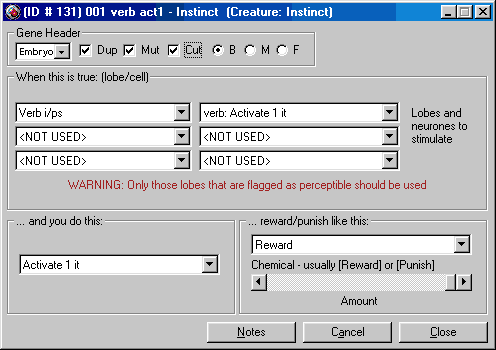
An instinct gene provides a way of training the neural net of the norn brain so it will react in certain ways in certain situations.
Instinct genes are often used to provide default behavior for things that are very important to the norn. Examples are responding to the verbs typed by the user. These genes do not provide behavior that will always occur. The experiences of the norn during its lifetime can override behavior defined by instincts.
Instincts are processed while a norn is being hatched and while a norn sleeps. It is very important for a norn to get regular sleep so the instincts are constantly reinforced. During this instinct processing time the lobes and neurones define in the gene are set inside the norn brain and the chemical (usually punishment or reward) is processed as if the norn had performed this action.
For example the instinct gene responding to the verb 'come' has the same effect when processed as if the norn had chosen the decision to 'come' when the user typed 'come' and then got a pat from the hand to reward it. This would encourage the norn to do this when awake.

The gene header is the same for all genes.
Allows selection of the lobes and cells that will be fired within those lobes. This indicates what the norn will need to perceive before it will decide to take the action defined in the 'and you do this' area. A combination of up to three different lobe/cells may be selected.
The Genetics Kit gives a warning that only those lobes marked as perceptible should be used. This makes sense as only the perceptible lobes contribute to forming concepts. Any other lobe will cause this instinct to have no real effect.
The lobes and their perceptible settings are:
| Lobe | Perceptible setting |
|---|---|
| Drive i/ps | Mutually exclusive |
| Stim source i/ps | No |
| Verb i/ps | Mutually exclusive |
| Noun i/ps | No |
| Gen/sense i/ps | Yes |
| Decision | No |
| Attention | Yes |
All lobes with a perceptible setting of 'Yes' or 'Mutually Exclusive' qualify as perceptible lobes so they should be able to be used in instincts.
This is the decision that the instinct will reinforce when the above lobe/cell combinations are active. Think of it as 'if the above lobe combinations occur then the norn will be more or less likely to make this decision depending on the reward/punish settings defined below.
Valid settings are any of the 16 possible decisions or verbs that the norn can perform:
| Default (Stay) |
|
Activate 1 it (Push) |
| Activate 2 it (Pull) |
| Deactivate it (Stop) |
| Approach it (Come) |
| Retreat from it (Run) |
| Get it (Get) |
| Drop all (Drop) |
| Say what you need (Think) |
| Rest (Sleep) |
| Travel west (Left) |
| Travel east (Right) |
|
Decision12 |
|
Decision13 |
| Decision14 |
| Decision15 |
This is where you select the chemical and amount of that chemical that will be injected into the norn when the above settings are made and the instinct processed. Although any of the 256 chemicals can be selected the only two that really make sense are 'Reward' or 'Punish'.
If 'Reward' is selected then the norn will be rewarded and encouraged to perform the action. If 'Punish' is selected then the norn will be discouraged and be less likely to perform the action defined.
Remember that instincts are only processed when a norn is born and while it sleeps. Too many instinct genes could cause a lot more sleep or longer sleep to be required for all the instincts to be processed. It may pay to have the more important instincts to be the lower numbered genes (as it appears to cycle through in gene number order).
Some instinct genes appear to use the Stim source lobe as an input even though it is not a perceptible lobe. I'm in the process of testing whether these instincts actually work as I suspect they may not. It depends whether the instinct processing mechanism still considers it as perceptible as the Stim source lobe feeds into the Attention lobe which is perceptible. Some research is needed here.
Although only 'Reward' and 'Punish' currently make sense for chemicals, others could be useful in genetically modified norns with different brain/chemical structures. There is scope for some interesting experimentation there.
Only three lobe/cell combinations can be defined. This appears to match the number of dendrite links between the perception lobe and the concept lobe in a standard hatchery norn. These norns allow up to three perceptions to form a concept.